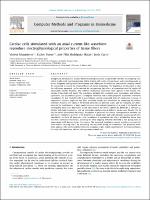Por favor, use este identificador para citar o enlazar este ítem:
https://repositorio.usj.es/handle/123456789/887
| Título : | Cardiac cells stimulated with an axial current-like waveform reproduce electrophysiological properties of tissue fibers |
| Autor: | Monasterio, Violeta



Pueyo, Esther 


Carro, Jesús 


Rodríguez-Matas, José Félix 


|
| Palabras clave : | Cardiac electrophysiological models; Multi-scale simulations; Stimulus current |
| Fecha de publicación: | nov-2022 |
| Editorial : | Elsevier |
| Descripción : | Background and objective: In silico electrophysiological models are generally validated by comparing sim- ulated results with experimental data. When dealing with single-cell and tissue scales simultaneously, as occurs frequently during model development and calibration, the effects of inter-cellular coupling should be considered to ensure the trustworthiness of model predictions. The hypothesis of this paper is that the cell-tissue mismatch can be reduced by incorporating the effects of conduction into the single-cell stimulation current. Methods: Five different stimulation waveforms were applied to the human ven- tricular O’Hara-Rudy cell model. The waveforms included the commonly used monophasic and biphasic (symmetric and asymmetric) pulses, a triangular waveform and a newly proposed asymmetric waveform (stimulation A) that resembles the transmembrane current associated with AP conduction in tissue. A comparison between single-cell and fiber simulated results was established by computing the relative difference between the values of AP-derived properties at different scales, and by evaluating the differ- ences in the contributions of ionic conductances to each evaluated property. As a proof of the benefit, we investigated multi-scale differences in the simulation of the effects induced by dofetilide, a selective I Kr blocker with high torsadogenic risk, on ventricular repolarization at different pacing rates. Results: Out of the five tested stimulation waveforms, stimulation A produced the closest correspondence between cell and tissue simulations in terms of AP properties at steady-state and under dynamic pacing and of ionic contributors to those AP properties. Also, stimulation A reproduced the effects of dofetilide better than the other alternative waveforms, mirroring the ’beat-skipping’ behavior observed at fast pacing rates in experiments with human tissue. Conclusions: The proposed stimulation current waveform accounts for inter-cellular coupling effects by mimicking cell excitation during AP conduction. The proposed wave- form improves the correspondence between simulation scales, which could improve the trustworthiness of single-cell simulations without adding computational cost |
| URI : | https://repositorio.usj.es/handle/123456789/887 |
| ISSN : | 0169-2607 |
| Aparece en las colecciones: | Artículos de revistas |
Ficheros en este ítem:
| Fichero | Descripción | Tamaño | Formato | |
|---|---|---|---|---|
| cardiac cells stimulated.pdf | 914,75 kB | Adobe PDF |  Visualizar/Abrir |
Este ítem está sujeto a una licencia Creative Commons Licencia Creative Commons

